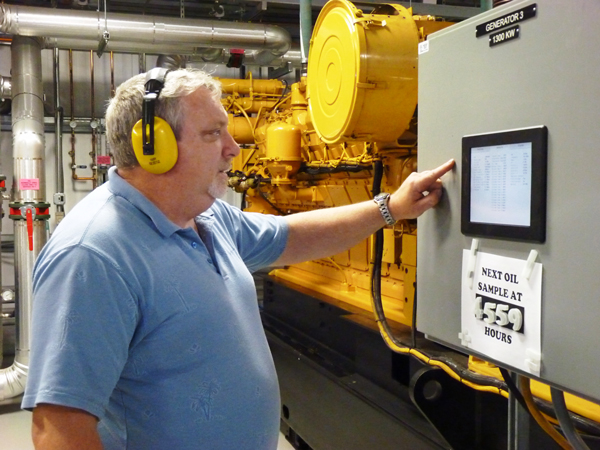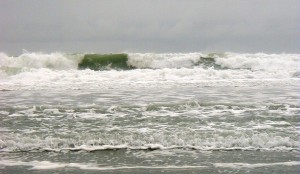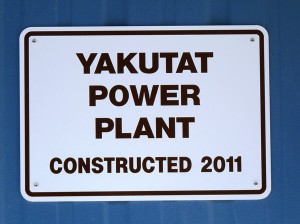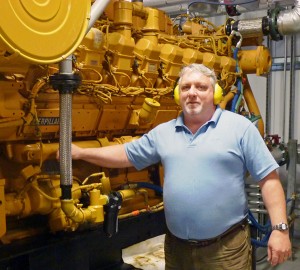
The northern Southeast city of Yakutat is gearing up for a wave-energy experiment. If it’s a success, the community of about 650 residents could lower its high, diesel-fueled power costs. The system could also be a model for some other isolated Alaska cities.

Scott Newlun opens the door to Yakutat’s new power plant, and it’s really loud.
It’s not so bad outside the sound-absorbing walls. And that’s good news for Newlun, who’s headed up Yakutat’s power system for 15 years.
“That new plant just changed the whole atmosphere, especially where I’m living, next door to it,” he says.
Its generators are more efficient, and Newlun’s proud of that. But power costs remain high.
“Since I’ve been involved here, that’s always been a goal, to find a different source of energy other than diesel fuel,” he says.
These days, he’s thinking about a power source with a different sound.
“Wave energy is about the most exciting thing we’ve got going,” he says.

Yakutat’s geography doesn’t work for hydro. Weather limits what you can get out of solar and wind. Wood-fueled biomass got serious consideration. But with only 450 electrical customers, it’s too small a market.
That’s why the town is looking toward the ocean.
A number of emerging technologies are available. Some use anchored buoys, others long lines of floats.
Yakutat’s trying out a smaller device called the Surge Wave Converter, made by Boston-based Resolute Marine Energy.
It’s sort of like a paddle, hinged to a base on the ocean floor.
“It reminds me of a kelp frond in the water, as waves go by. And it sways back and forth like that. It’s that slow and that mild,” he says.
The back-and-forth movement powers a pump, which pushes water through pipes to the shore. That pressure is the carbon-free energy that runs an electrical generator.

Resolute Marine has tested the Surge at a North Carolina research facility.
Yakutat Planner Bill Lucey says it’s time to try it out in the Gulf of Alaska.
“We know it makes electricity. It’s survived an East Coast storm. So now what we need to know is how much it is going to cost to anchor them to the bottom so they don’t bounce around in a West Coast storm,” he says.
Yakutat hoped to put a test unit in the water this year and add about a dozen more later on. But permitting and other delays pushed that back to 2015.
So the job now, for Lucey and others, is to research possible impacts to the community – and the environment.
“Your sharks and your rays can become attracted to underwater cables. But this project will simply pump pressurized sea water to a shore-based plant and the electricity will be generated on land,” he says.
Lucy says seabirds aren’t expected to be an issue, since the system’s underwater. Acoustic tests will look for impacts on whales and seals.
Commercial fisheries are being taken into account. And then there’s the surfers, attracted by the same ocean power that makes this project a possibility.

“There’s a lot of beach break all along that area. And if we put 14 of these panels out it’s not going to take out all the wave areas for surfing and it might not be an issue where they are,” he says.
Funding and technical help for this testing phase is coming from federal, state and local governments. Early estimates put the cost at about $3 million, but it could be higher.
Borough Manager Skip Ryman hopes it pencil out. But he’s trying to be realistic.
“The big question for us is, is wave energy feasible? Is it going to be something that will actually aid the consumer?” he says. “If wave energy proves to be more expensive than diesel, then certainly, that’s something that will throw it under bus for us.”
It’ll take a couple years ‘til that’s known. But Newlun remains optimistic.
“This might be huge. That’s what I’m hoping, you know. If we can harness some of the kinetic energy out of the ocean, it could change the face of power generation for the world,” he says.
Or at least, for some other coastal Alaska communities.
Ed Schoenfeld is Regional News Director for CoastAlaska, a consortium of public radio stations in Ketchikan, Juneau, Sitka, Petersburg and Wrangell.
He primarily covers Southeast Alaska regional topics, including the state ferry system, transboundary mining, the Tongass National Forest and Native corporations and issues.
He has also worked as a manager, editor and reporter for the Juneau Empire newspaper and Juneau public radio station KTOO. He’s also reported for commercial station KINY in Juneau and public stations KPFA in Berkley, WYSO in Yellow Springs, Ohio, and WUHY in Philadelphia. He’s lived in Alaska since 1979 and is a contributor to Alaska Public Radio Network newscasts, the Northwest (Public Radio) News Network and National Native News. He is a board member of the Alaska Press Club. Originally from Cleveland, Ohio, he lives in Douglas.




